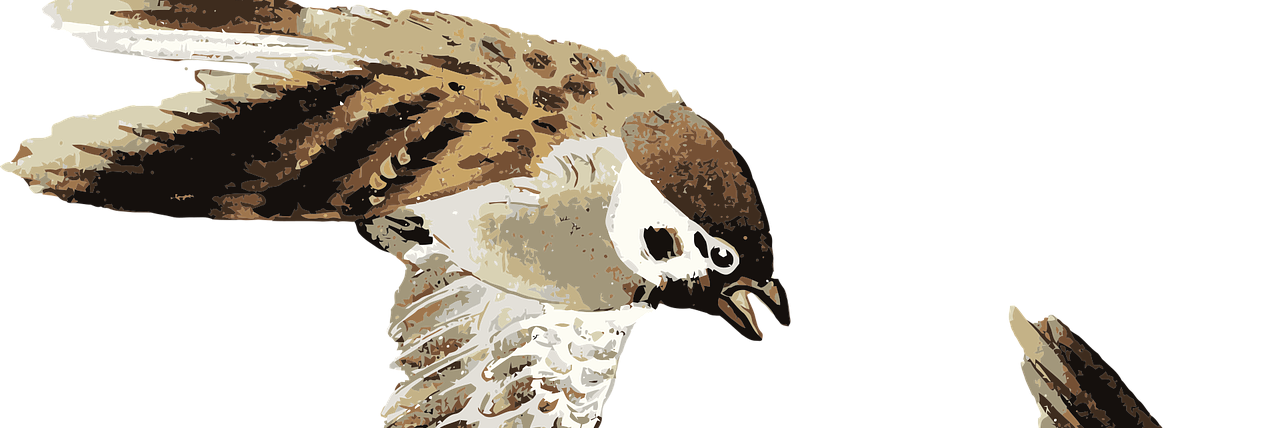
When Sparrows Fall to Earth
By Roger James
The Fulcrum, Issue 51 Autumn 2010
For the centenary of Charles Darwin’s birth last year there was much written and broadcast about the great man’s life. What struck me specially was the story of the death of his dearly-beloved young daughter Annie.
She was so ill, Darwin took her away to the spa at Malvern where she was attended by a doctor and received the water treatment. Sadly, she died there and this was chronicled in heart-broken letters from Darwin to his wife who had stayed at home with the rest of the children.
As is fitting in those who have reached their span of threescore years and ten, I have been pondering on this and what I have started to call the ‘quantum mystery’ of life. As those who have dabbled a little in quantum physics will know, it is a theory that makes little sense in terms of everyday experience. Big things like planets and tennis balls obey the laws of physics discovered by Newton. If they are really big or going really fast then Einstein’s relativity theory explains their behaviour, and this fits into the same theoretical universe as Newton’s. But come down to tiny things like electrons and photons and we enter a strange quantum universe where quite different laws apply. Both quantum theory and Newtonian physics have clear evidence to prove their truth, but no-one has the least idea how they fit together in one theory.
There are times when we have to look at two different views of the world and accept that, while both are true, there is no way of reconciling them.
Life is like that. Darwin’s theory of natural selection is supported by all the evidence anyone could wish, with the theory itself no doubt much advanced since his day. In this universe of life, the death of an individual is of little account – it is the number of breeding survivors of the species who count. After all, death is all around us every day: animals, birds, plants, bacteria as well as our own cells.
I pause briefly to note that it is not just the breeding adults which count. Grandmothers, for instance, whether elephant or human, have their evolutionary uses. But my point here is not about the nuances of evolutionary theory but the fact that in this struggle for survival the individual is of virtually no account: one blade of grass, one ant, one human being.
But there is a parallel, ‘quantum’ or spiritual universe where the death of an individual matters very much. Individuals go to great lengths to avoid their own death, as every wriggling worm attests. But it is the effect individual deaths can have on others that shows us something of the nature of this other universe of life. Think of the death of a parent, a sibling or any child.
What each of us has to decide is whether, in valuing life in all its forms as I feel sure many readers of this journal do, we are simply being sentimental or whether this is what life is really about. Or, if you like, is the spiritual real?
Where do we draw a line as regards the spiritual value of a life, which we would feel bound to defend? Our family, our nation, any human being, furry animals, sentient living things, all life?
Why try to help an old, sick person have a better quality of life, as many of us do? What about nurturing a struggling wild plant or sellotaping the broken shell of a snail in an effort to save it, as I heard one good soul used to do.
Wherever, as a spiritual being, you draw this line, never think that valuing life as a spiritual reality will ever make sense in terms of Darwin’s theory. The two realities are like quantum and Newtonian physics, existing side by side but neither explaining the other. Natural selection must surely be an essential mechanism of life, yet the value of individual life is so real to many of us that we scarcely stop and question it.
This insoluble paradox has fundamental repercussions. Huge sums and huge effort go into preserving and prolonging human life. If medical research could save the life of every child who dies of malaria or every victim of AIDS then it would be seen quite rightly as a triumph of science. But such interference in natural selection is arguably destroying our living world as the human population spirals out of control and there is a mass extinction of species. Can these things be reconciled? I would say not.
The death of Darwin’s daughter had a minimal effect on the human population. He and his wife had many other children. But that was no comfort for Darwin and his wife when Annie died at the age of ten.
We can take this further when we think about the tension that exists between complementary therapies such as ours and modern medical science. There are those who hope to reconcile the two worlds by seeking evidence which will convince every doctor in the land. I have always thought that this is a vain hope and that complementary therapies will continue to provide enormous help to many people, but at the same time be regarded with scorn by the medical establishment.
There are times when we have to look at two different views of the world and accept that, while both are true, there is no way of reconciling them. This may be difficult for our searching minds to accept, but it seems that sometimes we have no choice.
Roger James died in 2018 aged 80. He was integral to the development of the CSTA and devoted much time to promoting CST.
The opinions expressed in this article are those of the author and do not necessarily reflect the viewpoints of the CSTA.

